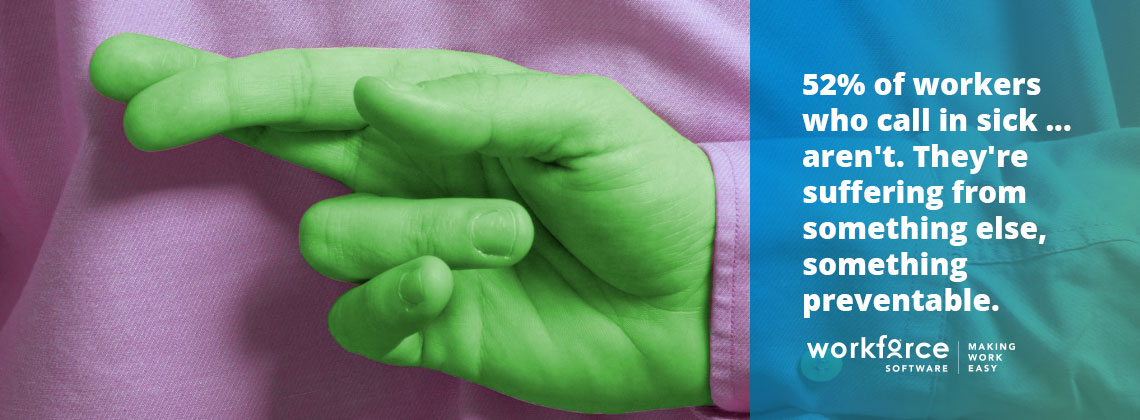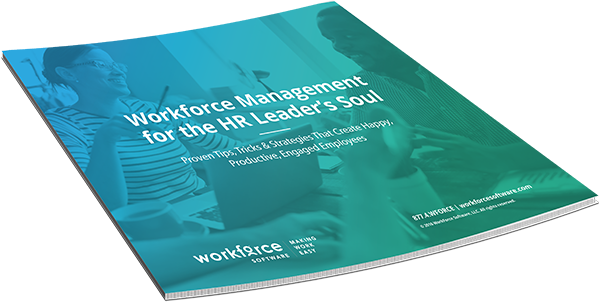“Sick” Day: Why Employees Lie

Richard woke up a few minutes before his Monday alarm, comfortable and refreshed.
Twenty minutes later, he was showered and dressed, sitting at his kitchen table, drinking black coffee, grazing on a plate of fruit. Richard’s Labrador, Sam, sat patiently under the table, waiting to be walked.
“Just a second, girl,” said Richard, taking out his phone. He pulled up his work email and started a new draft to his boss:
Hi Naomi,
It’s been a miserable morning. I have a migraine. I can barely type this. Sorry, but I have to stay home again.
Richard pressed SEND and immediately looked down at Sam.
“You ready?” he said.
Sam sprung off the floor, wagging her tail and panting. By 9:01, they were at the dog park, enjoying the sun together.
Subscribe to The WorkForce Blog
Learn the art and science of maintaining productive, happy, engaged employees.
Richard lied to his manager, but why?
According to Paula Allen, the VP of research at Monreau Shepell, a benefits consulting firm, about one in every two (52%) unscheduled sick days is taken by workers who aren’t sick at all.
Allen’s research says people call out because they’re stressed—acutely or chronically, consciously or otherwise. And while their stress could be brought on by many issues, it’s most commonly associated with an ongoing work-life imbalance.
Chronic workplace stress is a serious problem, as it will eventually bleed into an employee’s personal life, affecting relationships and overall happiness, which only compounds the symptoms.
Most managers, rightfully, give their people the benefit of the doubt when they call out. That said, they also know what’s going on: a Monreau Shepell survey shows that only a third of managers believe that illness is a top-three reason for calling in sick.
And trying to fix the issue using rudimentary absence management strategies (i.e., asking employees for a doctor’s note) won’t work in the long run. After a brief dip, absence rates would typically return to normal.
“About one in every two unscheduled sick days is taken by workers who aren’t sick at all”
To make a lasting difference, then, employers have to fix the core issue: stress caused by work-life imbalance.
It’s an important, even crucial effort to make because, ultimately, stress results in more than misused sick days. That’s the surface issue, the superficial layer. Employee engagement, happiness, and productivity is what lies beneath. That is what’s at stake—along with your bottom line.
10 work-life benefits designed to delight employees and temper stress
Companies across Sweden are implementing the 6-hour work day. One such employer, Swedish CEO, Linus Feldt, says the shortened hours help his staff focus throughout the day and have enough energy after work to enjoy their personal lives.
Meanwhile, the rest of world seems to be working longer hours, letting work seep into their off-time slowly, yet methodically, through tech. At first, the drive to work is spurred by responsibility, then by guilt, and finally by compulsion.
Does every country need to adopt a 6-hour work day? No. At least, not yet. There are other ways to help manage employee stress. We can all learn from the benefits offered by these progressive companies*:
1. REI: “Yay Days”
The outdoor retail giant gives every employee a couple paid days off to go outside and enjoy themselves. They’re called “Yay Days”—and Richard would be all over them.
2. Netflix: Paid Parental Leave
If you have a baby while working at Netflix, your manager will congratulate you, and then give you an unprecedented year of paid leave.
3. World Wildlife Fund: “Panda Fridays”
Employees at the renowned nonprofit get 52 Fridays off a year.
4. Airbnb: Annual Stipend
The winner of Glassdoor’s Best Places to Work list gives everyone on the payroll $2,000 a year to stay in Airbnbs all over the world.
5. Twillo: Freebies
Calling all readers: this cloud comm company gives employees a free Kindle and $30 a month to spend on books.
6. Twitter: On-site bliss
Acupuncture therapy, improv classes, and three square meals a day: just a few perks enjoyed by those who keep Twitter.com the 8th most visited URL on the Internet.
7. Accenture: Commitment to LGBTQ
Chicago-based Accenture is committed to LGBTQ rights and diversity, which is why it covers gender reassignment procedures for their employees.
8. Facebook: “Baby Cash”
Mark Zuckerberg & Co. provides $4,000 to employees with a newborn.
9. Epic Systems Corporation: Paid Sabbaticals
If you’ve worked at this privately held software company for more than five years, you get a paid four-week sabbatical to do, well, whatever you want.
10. Google: Financial Security
The search king famously shares its riches with its people. But Google makes the free products and free time it dispenses seem trivial under the weight of their spousal benefit, which provides the surviving husband, wife, or partner of a deceased employee with 50% of that worker’s salary for 10 years.
 Workforce Management for the HR Leader’s Soul
Workforce Management for the HR Leader’s Soul
This book will help you create a healthy, rewarding environment for the people that keep your company moving forward.
Would these benefits de-stress Richard?
Perhaps. But that doesn’t mean Richard’s company can afford to provide them.
That said, every organization can learn from the sentiment behind these benefits: be kind, be generous, and do everything in your power to care for your most important assets. If Richard worked for a company that owned these values, he probably wouldn’t feel obligated to lie when he needed a day to himself.
“As a company, be kind, be generous, and do everything in your power to care for your most important assets.”
Fostering a transparent, positive, employee-centric environment is fundamental to developing workplace trust.
One way to do so is by making absence management an easy process for employees and their managers, which, in turn, will help your company manage workflows, stay current with the latest regulations, determine eligibility, meet due dates, and establish clear return-to-work guidelines.
Another way is to provide fantastic benefits, creating a workplace culture that supports employees’ health and work-life balance.
Should your perks be on-par with those offered by Google or Netflix or Airbnb? If you can swing it, sure! And if not, that’s okay, too: because adopting the way these companies think is a potent, powerful start in its own right.
*Original list curated by FastCompany.
Foster trust.
Give your employees (and yourself) the gift of
WorkForce Management Software.

 Workforce Management for the HR Leader’s Soul
Workforce Management for the HR Leader’s Soul